The Three Passes Trek is considered the hardest multi-day journey to Everest. In a period of 17 to 20 days, you ascend to six peaks that are higher than 5300m, climb near vertical terrain, and gaze at four of the world's eight tallest mountains: Cho Oyu (8201m), Makalu (8481m), Lhotse (8414m) and Everest (8848m). Instead of short days followed by acclimatization hikes, the Three Passes trek takes you on long days that end with glaciers, boulders bigger than houses, and valleys straight out of Lord of the Rings. In short, it's the ultimate Everest experience, especially when you organize it in your own, trek it without guides or porters, and pick up amazing friends along the way.
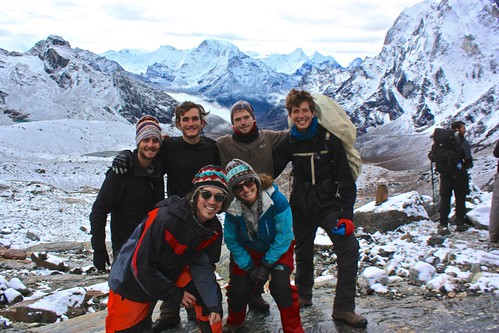
NOTE: I took the iPad with me on our trek and wrote most of this trip diary in real-time. Because of that, it doesn't share the same format as our other posts, but it does provide an accurate account of our oscillating excitement and exhaustion on the mountain.
Here's our account of 17 days that were among the most difficult of our lives. For trekking days 1-4, 5-8, and 13-17, click on the respective links.
Total Spent Over 17 Days: US$1309 (including flights to/from Lukla, permits, all food and lodging) Average Spent Per Person/Day: US$38.50
Day 9: Lobuche to Gorak Shep (5130m); day hike to Everest Base Camp (5364m)
Stats: 2 hours trekking with light pack; 3 hour round trip hike to EBC
We left Lobuche at a leisurely hour with our Israeli friends and had a relatively easy hike to Gorak Shep, which would be the highest sleeping stop of our trek. Along the way, we bumped into lots of friends we had made before detouring to the Kongma La, which made the walk pleasant despite the freezing cold weather, sleet, and altitude.

After settling into the Himalaya Lodge (free room at the best place in town), we ate lunch and got ready to go to Everest Base Camp. Unfortunately, just as we were putting on our gear, it started blizzarding. So we sat, and sat, and sat, making new friends and catching up with ones we'd met previously on the trail.
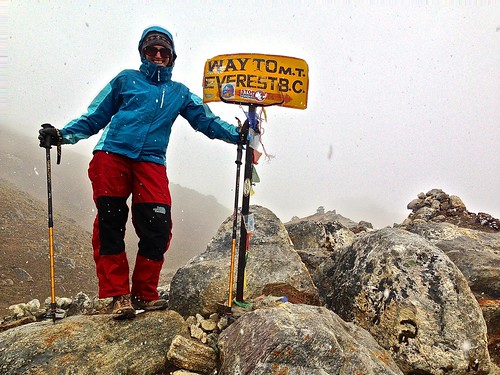
An hour later, at 1:30pm, we decided to go for it since the weather didn't seem to be improving and we didn't want to spend more days than necessary at 5100m. Five of us took off through the snow and less than two hours later, we were there. Base Camp. The reason we had all come.
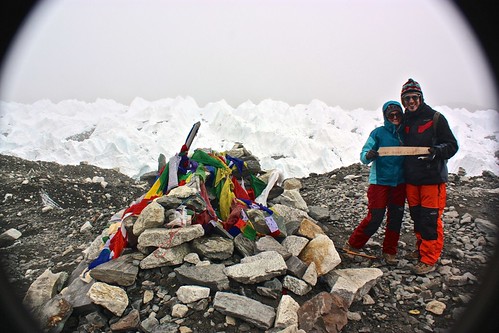
Most people say to skip EBC entirely since there are no views of Everest, but I think they're wrong. While you may not get mountains, you get an amazing glacier with tons of glacial lakes and tunnels and many opportunities for stupid photo opps.
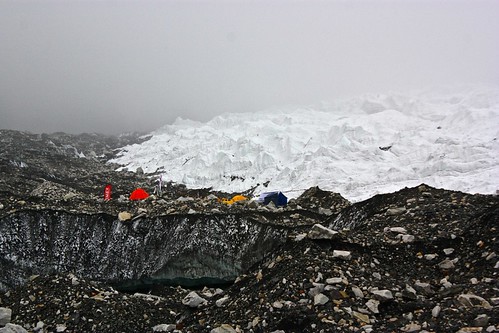
The ice formations in the background are also impressive, particularly with a fresh coat of snow.
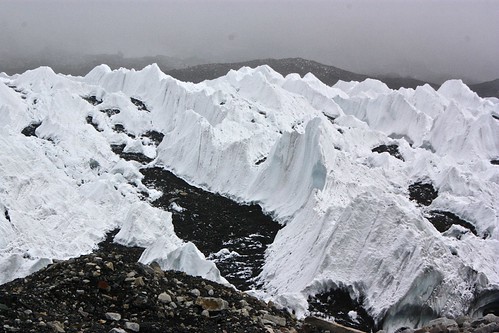
It was probably because of the late hour and iffy weather, but perhaps the best part of our Base Camp experience was that we were the only people there except for the crazy climbers hoping to summit. Atypical for sure, but we couldn't have asked for a better afternoon.
Day 10: Sunrise hike to Kala Patthar (5550m) from Gorak Shep; Gorak Shep to Dzongla (4830m)
Stats: 3.5 hour roundtrip hike to Kala Patthar; 4 hour trek with pack to Dzongla
This morning was the most difficult one of the trek. We woke up at 4:00am to start hiking to Kala Patthar, which on a clear morning is supposed to provide one of the best views of the Everest range. We were out the door by 4:30, but instead of being greeted by a starlit sky, we met rain and clouds. Trekking up a mountain in the dark and in the middle of a cloud was both exhausting and demotivating, and things only got worse when our water hose froze about 30 minutes in.
With frozen toes and fingertips despite wearing four layers of clothes, one foot in front of the other took on a whole different and more painful meaning. The hike up takes most people between 1.5 and 2 hours and this was the one time when we walked much slower than the average trekker. About one hour into the hike we stopped. We were tired, cold, and in a cloud.
And then the unbelievable happened.
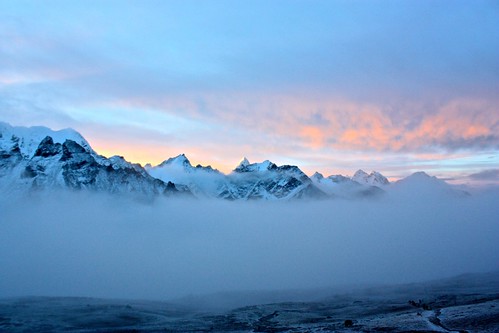
Through the clouds, we began to see what looked like a mountain. And next to it was another one, and another one, and another one. Within ten minutes, as the sky began to light up with the first rays of daybreak, the Everest range appeared in full view.

It was incredible, so close it appeared you could touch it, and backlit by a sky of pink and orange.
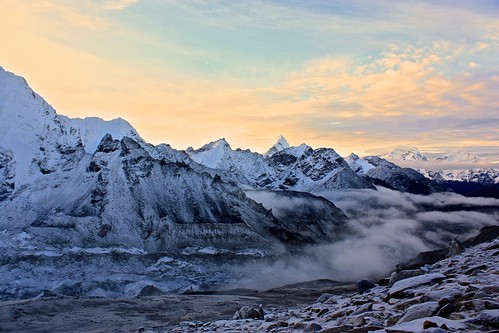
The unexpected views and dissipating cloud gave us the energy we needed to make it to the top, though the hike took almost 2.5 hours.
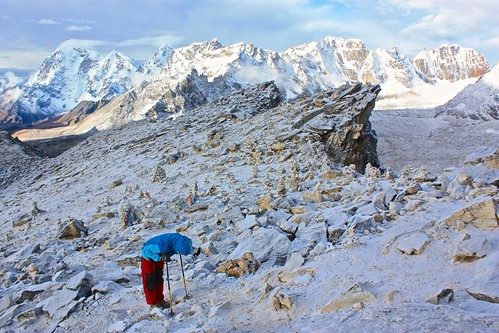
Standing at the top of Kala Patthar, which was nothing more than a mound of black rock, was a dizzying experience. With the tallest mountains in the world surrounding us, a steep precipice below us, and a feeling of intense achievement inside us, all we could do was gasp for breath, grin uncontrollably, and dance!
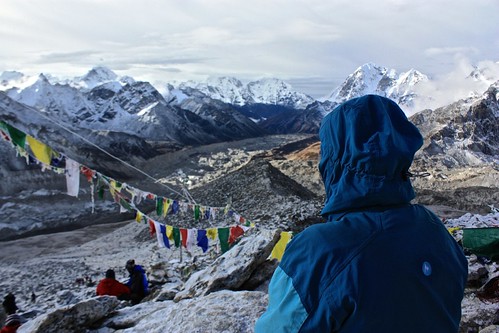
Getting down was easier than getting up, but it posed its own unique challenges when it came to jumping down from icy boulders larger than me. Thankfully, a kind man from Korea saw my anguish and lifted me down like a Raggedy Ann doll. If only he had carried me the whole way...
With a tight schedule, our day didn't end with a sunrise hike or an easy walk to Lobuche. Instead, we pushed on to Dzongla, through sleet, rain, and snow. The hike wasn't a difficult one, but the conditions put a very literal damper on our exciting morning. Fun in the sun, anyone?

You just never know in the mountains. A blistering snowy morning transformed into the most amazing and clear view, which an hour later was a full-on blizzard.
Day 11: Planned hike over Cho La Pass that ended up as a rest day
Stats: Lots of sitting around and eating
We woke up at 5:30am to rain, sleet, and fog. After eating breakfast, we decided that doing the pass in this weather was pointless as we wouldn't be able to see anything. Instead, we spent the day eating, playing cards, and talking about politics and the stock market.
Day 12: Dzongla to Cho La Pass (5420m) to Gokyo (4800m)
Stats: 8.5 hours trekking with packs

Our second attempt at the Cho La was a triumphant and exhausting success. After waking up to crystal clear views of Ama Dablam (6812m) and the surrounding mountain range, we took off up the mountain and reached what we thought was the peak of the pass about two hours in, after a short scramble over snow-covered rocks.

The views were unbelievable and we couldn't help but have some more amazing freshly brewed coffee and a full-on dance party.
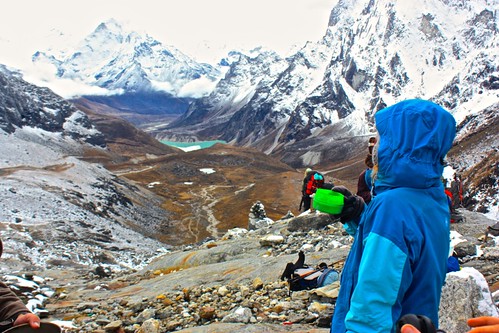
Our joy came to an abrupt halt when a guide told us that the true pass was still 30 minutes away. We made our way over more snow-covered boulders and a field topped with at least a foot of snow before reaching the true pinnacle of Cho La.

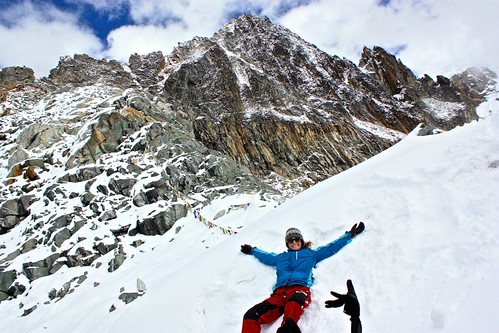
The views here didn't compare to the fake "summit" so we didn't spend much time at the top before starting the challenging descent.
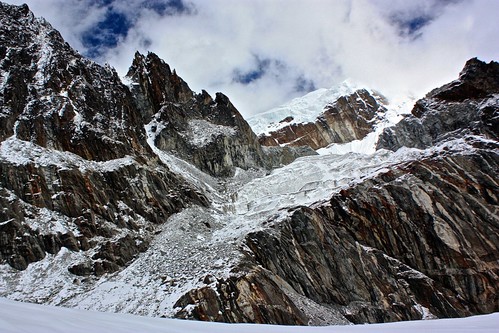
The way down from Cho La is steep and slippery in the best of times, but we were here after a snowstorm, which meant a foot and a half of snow covering both rocks and empty space. There was no way to walk it without slipping and breaking bones, so we spent most of the descent either on our butts or in a squat position sliding down the mountain. It was actually quite fun, but it took about an hour longer than it should have to make our way down.
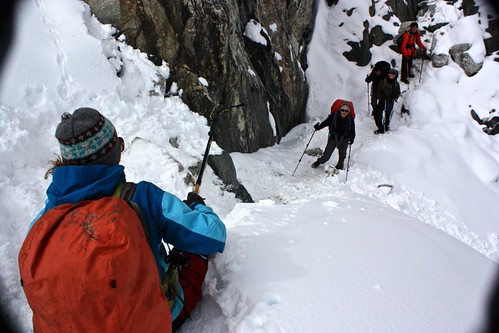
The challenge with deep snow is that you can't see what it covers, something I learned almost at the bottom of the pass when my foot fell through the snow into a razor sharp edge of a buried rock. After some tears, I got back up and we continued down off the rocks and into the valley, which thankfully had no snow.
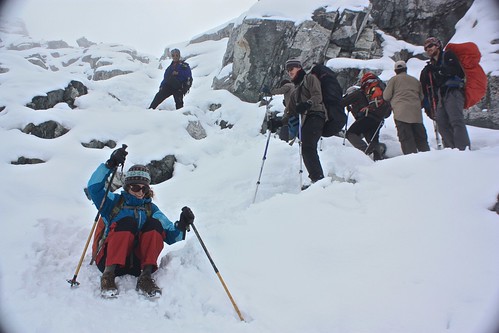
About an hour and a half later, after being assaulted by balls of hail and fog so thick we couldn't see more than a few feet in front of our poles, we finally reached Dragnag (4700m).
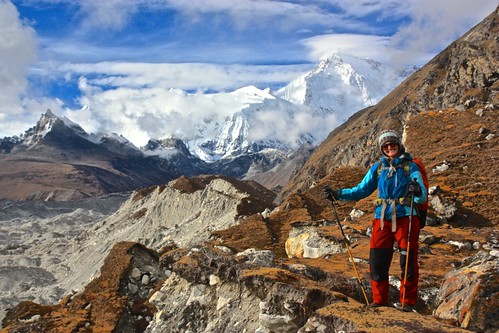
Back on the road after a fast lunch, we climbed up and into the Ngozumba Glacier, the longest in Nepal. The map shows an immediate crossing from east to west, but the actual path took us up the glacier for about 20 minutes before starting the crossing, which went up and down glacial mountains. This glacier wasn't as difficult as the one on the Kongma La pass, but we were starting to get worried because the crossing was taking much longer than the one hour the map stated.
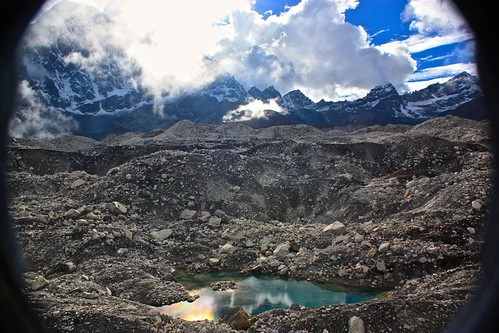
Still the views, despite the dirty look of the ice, were wonderful with lots of glacial lakes, foot-long icicles, and insane faces peering at us from the ice wall.

We realized that the map was completely wrong about the path across the glacier when we emerged on the other side of the glacier and saw Gokyo and the third lake right below us. After some celebratory photos of the lake and the mountains in the background, we descended down into Gokyo and settled into the Gokyo Resort, for another free stay.

(Note: although I really liked the food and atmosphere at Gokyo Resort, I would not stay here again. The female owner accosted one of our Israeli friends about eating lunch outside of the hotel and chased him out with a broomstick. Despite the incident being humorous to look back on, she was way out of line.)
More Everest
For more detail on trekking days 1-4, 5-8, and 13-17, please click on the respective links. You can also check out our top tips for hiking Everest Base Camp.
Interested in seeing Mount Everest and the Himalayas without the pain of trekking? Check out our Everest Three Passes photo tour.
You can also share your tips for trekking Everest on a budget by leaving a comment!
Comments